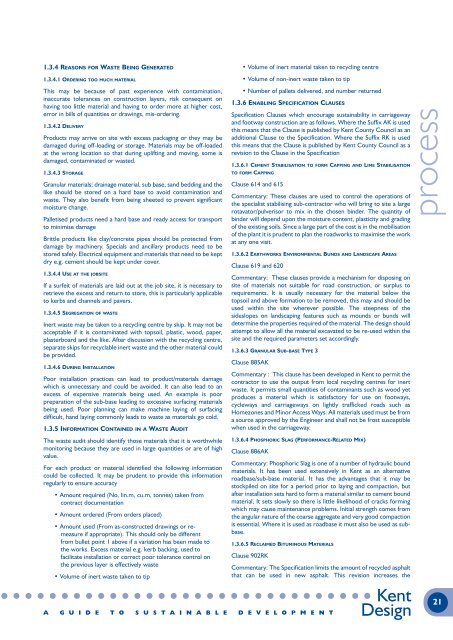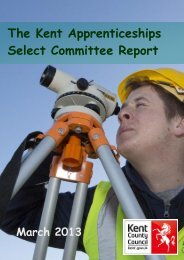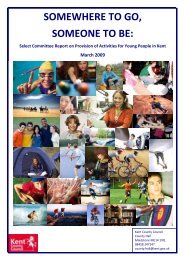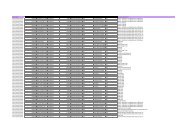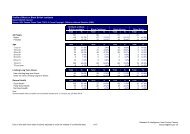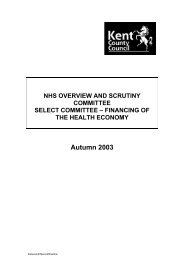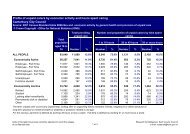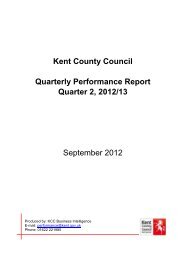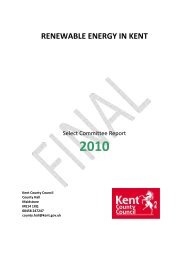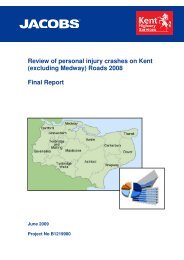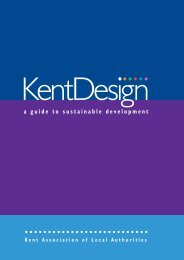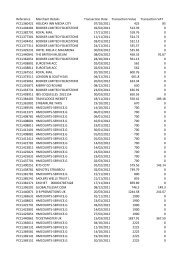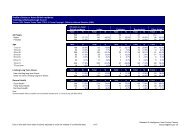Kent Design - Technical Appendix - Kent County Council
Kent Design - Technical Appendix - Kent County Council
Kent Design - Technical Appendix - Kent County Council
Create successful ePaper yourself
Turn your PDF publications into a flip-book with our unique Google optimized e-Paper software.
1.3.4 REASONS FOR WASTE BEING GENERATED<br />
1.3.4.1 ORDERING TOO MUCH MATERIAL<br />
This may be because of past experience with contamination,<br />
inaccurate tolerances on construction layers, risk consequent on<br />
having too little material and having to order more at higher cost,<br />
error in bills of quantities or drawings, mis-ordering.<br />
1.3.4.2 DELIVERY<br />
Products may arrive on site with excess packaging or they may be<br />
damaged during off-loading or storage. Materials may be off-loaded<br />
at the wrong location so that during uplifting and moving, some is<br />
damaged, contaminated or wasted.<br />
1.3.4.3 STORAGE<br />
Granular materials; drainage material, sub base, sand bedding and the<br />
like should be stored on a hard base to avoid contamination and<br />
waste. They also benefit from being sheeted to prevent significant<br />
moisture change.<br />
Palletised products need a hard base and ready access for transport<br />
to minimise damage<br />
Brittle products like clay/concrete pipes should be protected from<br />
damage by machinery. Specials and ancillary products need to be<br />
stored safely. Electrical equipment and materials that need to be kept<br />
dry e.g. cement should be kept under cover.<br />
1.3.4.4 USE AT THE JOBSITE<br />
If a surfeit of materials are laid out at the job site, it is necessary to<br />
retrieve the excess and return to store, this is particularly applicable<br />
to kerbs and channels and pavers.<br />
1.3.4.5 SEGREGATION OF WASTE<br />
Inert waste may be taken to a recycling centre by skip. It may not be<br />
acceptable if it is contaminated with topsoil, plastic, wood, paper,<br />
plasterboard and the like. After discussion with the recycling centre,<br />
separate skips for recyclable inert waste and the other material could<br />
be provided.<br />
1.3.4.6 DURING INSTALLATION<br />
Poor installation practices can lead to product/materials damage<br />
which is unnecessary and could be avoided. It can also lead to an<br />
excess of expensive materials being used. An example is poor<br />
preparation of the sub-base leading to excessive surfacing materials<br />
being used. Poor planning can make machine laying of surfacing<br />
difficult, hand laying commonly leads to waste as materials go cold.<br />
1.3.5 INFORMATION CONTAINED IN A WASTE AUDIT<br />
The waste audit should identify those materials that it is worthwhile<br />
monitoring because they are used in large quantities or are of high<br />
value.<br />
For each product or material identified the following information<br />
could be collected. It may be prudent to provide this information<br />
regularly to ensure accuracy<br />
• Amount required (No, lin.m, cu.m, tonnes) taken from<br />
contract documentation<br />
• Amount ordered (From orders placed)<br />
• Amount used (From as-constructed drawings or remeasure<br />
if appropriate). This should only be different<br />
from bullet point 1 above if a variation has been made to<br />
the works. Excess material e.g. kerb backing, used to<br />
facilitate installation or correct poor tolerance control on<br />
the previous layer is effectively waste<br />
• Volume of inert waste taken to tip<br />
• Volume of inert material taken to recycling centre<br />
• Volume of non-inert waste taken to tip<br />
• Number of pallets delivered, and number returned<br />
1.3.6 ENABLING SPECIFICATION CLAUSES<br />
Specification Clauses which encourage sustainability in carriageway<br />
and footway construction are as follows. Where the Suffix AK is used<br />
this means that the Clause is published by <strong>Kent</strong> <strong>County</strong> <strong>Council</strong> as an<br />
additional Clause to the Specification. Where the Suffix RK is used<br />
this means that the Clause is published by <strong>Kent</strong> <strong>County</strong> <strong>Council</strong> as a<br />
revision to the Clause in the Specification<br />
1.3.6.1 CEMENT STABILISATION TO FORM CAPPING AND LIME STABILISATION<br />
TO FORM CAPPING<br />
Clause 614 and 615<br />
Commentary: These clauses are used to control the operations of<br />
the specialist stabilising sub-contractor who will bring to site a large<br />
rotavator/pulverisor to mix in the chosen binder. The quantity of<br />
binder will depend upon the moisture content, plasticity and grading<br />
of the existing soils. Since a large part of the cost is in the mobilisation<br />
of the plant it is prudent to plan the roadworks to maximise the work<br />
at any one visit.<br />
1.3.6.2 EARTHWORKS ENVIRONMENTAL BUNDS AND LANDSCAPE AREAS<br />
Clause 619 and 620<br />
Commentary: These clauses provide a mechanism for disposing on<br />
site of materials not suitable for road construction, or surplus to<br />
requirements. It is usually necessary for the material below the<br />
topsoil and above formation to be removed, this may and should be<br />
used within the site wherever possible. The steepness of the<br />
sideslopes on landscaping features such as mounds or bunds will<br />
determine the properties required of the material. The design should<br />
attempt to allow all the material excavated to be re-used within the<br />
site and the required parameters set accordingly.<br />
1.3.6.3 GRANULAR SUB-BASE TYPE 3<br />
Clause 885AK<br />
Commentary : This clause has been developed in <strong>Kent</strong> to permit the<br />
contractor to use the output from local recycling centres for inert<br />
waste. It permits small quantities of contaminants such as wood yet<br />
produces a material which is satisfactory for use on footways,<br />
cycleways and carriageways on lightly trafficked roads such as<br />
Homezones and Minor Access Ways. All materials used must be from<br />
a source approved by the Engineer and shall not be frost susceptible<br />
when used in the carriageway.<br />
1.3.6.4 PHOSPHORIC SLAG (PERFORMANCE-RELATED MIX)<br />
Clause 886AK<br />
Commentary: Phosphoric Slag is one of a number of hydraulic bound<br />
materials. It has been used extensively in <strong>Kent</strong> as an alternative<br />
roadbase/sub-base material. It has the advantages that it may be<br />
stockpiled on site for a period prior to laying and compaction, but<br />
after installation sets hard to form a material similar to cement bound<br />
material, It sets slowly so there is little likelihood of cracks forming<br />
which may cause maintenance problems. Initial strength comes from<br />
the angular nature of the coarse aggregate and very good compaction<br />
is essential. Where it is used as roadbase it must also be used as subbase.<br />
1.3.6.5 RECLAIMED BITUMINOUS MATERIALS<br />
Clause 902RK<br />
Commentary: The Specification limits the amount of recycled asphalt<br />
that can be used in new asphalt. This revision increases the<br />
A G U I D E T O S U S T A I N A B L E D E V E L O P M E N T<br />
<strong>Kent</strong><br />
<strong>Design</strong><br />
process<br />
21


